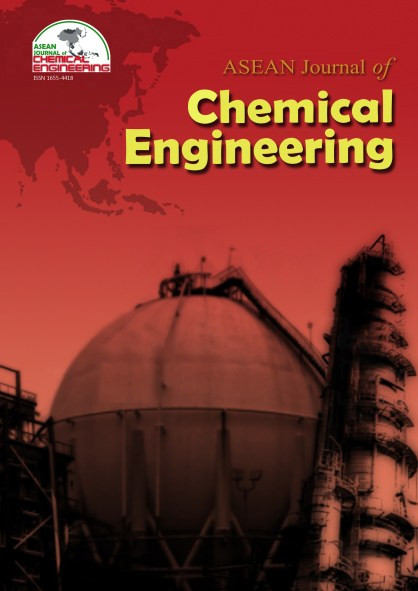Hybrid Coal: Effects Of Composition And Co-pyrolysis Retention Time in Low Rank Coal and Biomass Waste Co-pyrolysis Process on The Product’s Yield
Abstract
Low rank coal upgrading into a more efficient and environmentally friendly fuel can be done through copyrolysis with biomass into a fuel called hybrid coal. The purpose of the research is to determine the effects of biomass composition and copyrolysis retention time to the hybrid coal yields. Copyrolysis process conducted in a vertical tubular fixed bed reactor in an inert condition with atmospheric pressure and temperature set at 300oC. Inert condition achieved by flowing nitrogen gas into the reactor with a flowrate of 1.6 L/minutes. Biomass mixing composition is varied at 20, 30, and 40% from the total weight of the mixture. Copyrolysis retention time varied at 30, 60, and 90 minutes. Hybrid coals are characterized by proximate analysis, ultimate analysis, and calorific value measurement. Increase in retention time of copyrolysis from 30 to 90 minutes causing an increase in calorific value of 12.57-23.80%. From the proximate analysis results, fixed carbon content rise with the increase of co-pyrolysis time. The highest fixed carbon content obtained in the variation of 90 minutes, in the range of 49.36-49.75%. Increasing of sawdust composition from 20 to 40%, lowering the calorific value in the range of 0.58-8.55%.References
2. Jeong. H.J.; Hwang. J.H.; Seo. D.K.; Park. S.S. Journal of Thermal Analytical Calometry 1867-1875; 120(3)(2015)
3. Lee. D.W.; Bae. J.S.; Lee.Y.J.; Park. S.R.; Hong. J.C.; Lee. B.H. Environmental Science and Technology 1704-1710; 37 (2013)
4. Park. D.K.; Kin. S.D.; Lee. S.H.; Lee. J.G. Bioresource Technology 6151-6156; 101 (2010)
5. Rizkiana. J.; Guan. G.; Widayatno. W.B.; Hao. X.; Huang. W.; Tsutsumi. A.; Abudula. A.Fuel 414-419; 134 (2014)
6. Sasongko. D.; Wulandari. W.; Rubani. I.S.; Rusydiansyah. R. AIP Conference Proceedings; 1805(1)(2017)
7. Basu. P.Elsevier. Inc.. Oxford (2013)
8. Bergman. P.C.A.; Boersma. A.R.; Zwart. R.W.R.; Kiel. J.H.A.. Energy research Centre of the Netherlands ECN-C—05-013 (2005)
9. Guo. M.; and Bi. J.-C. Fuel Processing Technology 743–749; 138 (2015)
10. Quan. C.; Xu. S.; An. Y.; Liu. X. Journal of Thermal Analysis and Calorimetry 817–823; 117 (2014)
11. Sonobe. T.; Worasuwannarak. N.;Pipatmamomai. S. Fuel Process Technology 1371-1378; 89(12) (2008)
12. Blesa. M. J.; Fierro. V.; Miranda. J. L.; Moliner. R.; Palacios. J. M. Fuel Process Technology 1-17; 74(1) (2001)
13. Shui. H.; Shan. C.; Cai. Z. Energy 6645-6650; 36(11) (2011)
14. Rizkiana, J.; Guan, G.; Widayatno, W. B.; Yang, J.; Hao, X.; Matsuoka, K.; Abudula, A. RSC Advances 2096-2105; 6(2016)
15. Chen. C.; Ma. X.; He. Y. Bioresources Technology 264-273; 117 (2012)
16. Li. S.; Chen. X.; Liu. Y.J.; Wang. L.; Yu. G. Bioresources Technology 414-420; 179 (2015)
17. Moghtaderi. B.; Meesri. C.; Wall. T.F.Fuel 745-750; 83(6) (2004)
18. Aboyade. A. O.; Carrier. M.; Meyer. E. L.; Knoetze. H.; G ̈orgens. J. F. Energy Conversion Management 198-207; 65 (2013).
Copyright holder for articles is ASEAN Journal of Chemical Engineering. Articles published in ASEAN J. Chem. Eng. are distributed under a Creative Commons Attribution-NonCommercial 4.0 International (CC BY-NC 4.0) license.
Authors agree to transfer all copyright rights in and to the above work to the ASEAN Journal of Chemical Engineering Editorial Board so that the Editorial Board shall have the right to publish the work for non-profit use in any media or form. In return, authors retain: (1) all proprietary rights other than copyright; (2) re-use of all or part of the above paper in their other work; (3) right to reproduce or authorize others to reproduce the above paper for authors’ personal use or for company use if the source and the journal copyright notice is indicated, and if the reproduction is not made for the purpose of sale.



